Unit 9 What does he look like? Section A词汇讲解课件(共21张PPT)
文档属性
| 名称 | Unit 9 What does he look like? Section A词汇讲解课件(共21张PPT) |  | |
| 格式 | pptx | ||
| 文件大小 | 137.4KB | ||
| 资源类型 | 教案 | ||
| 版本资源 | 人教新目标(Go for it)版 | ||
| 科目 | 英语 | ||
| 更新时间 | 2022-05-07 16:41:44 | ||
图片预览

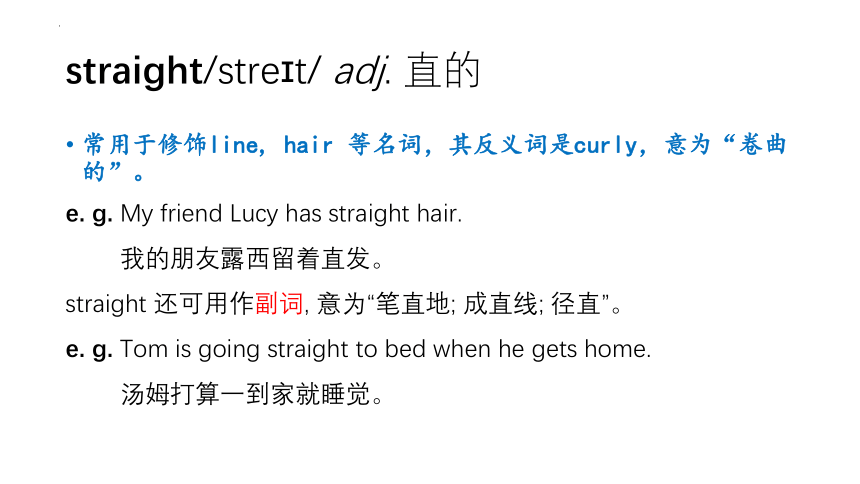


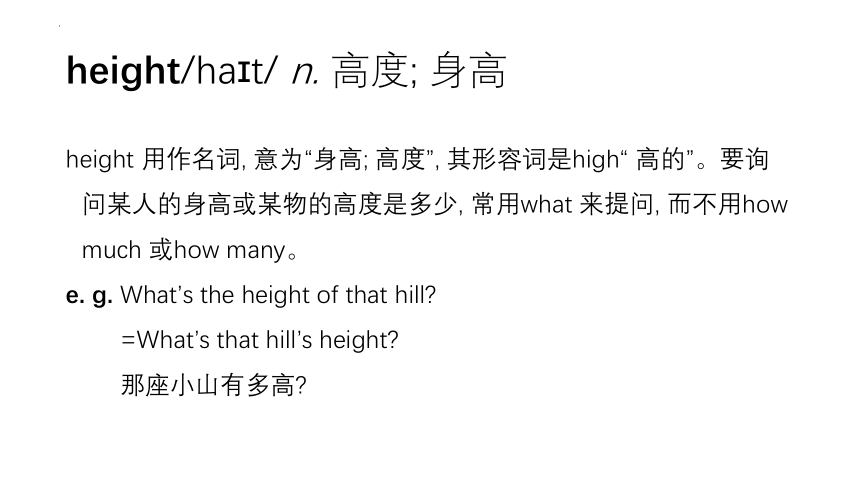
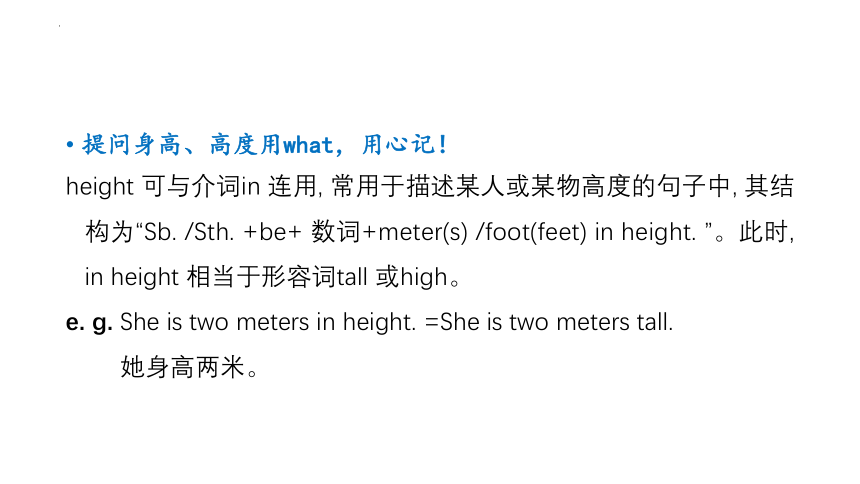
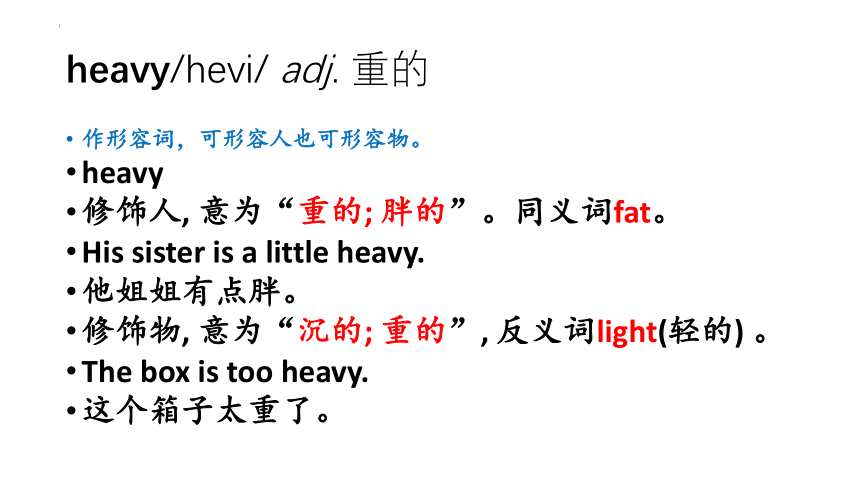
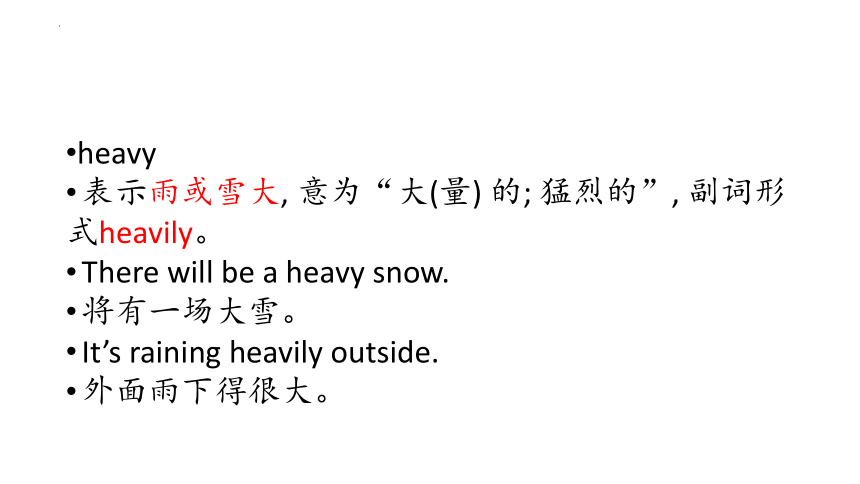
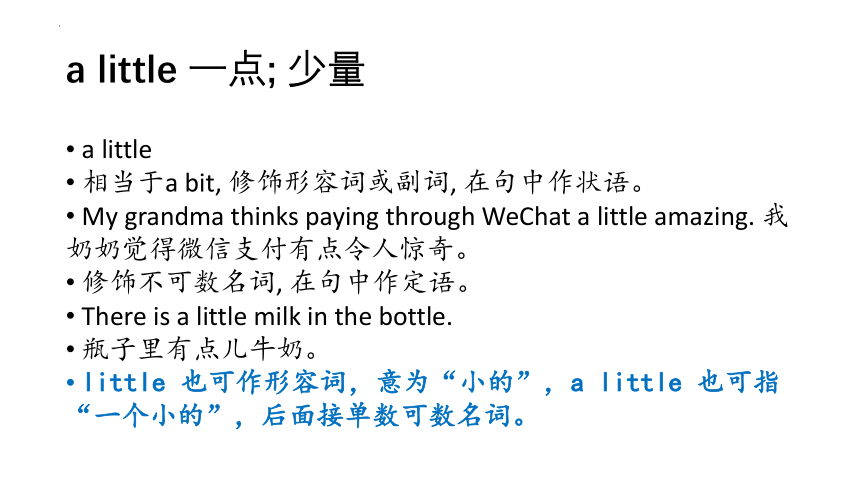
文档简介
(共21张PPT)
人教版英语七年级下册Unit 9 Section A
词汇讲解
straight/stre t/ adj. 直的
常用于修饰line, hair 等名词,其反义词是curly,意为“卷曲的”。
e. g. My friend Lucy has straight hair.
我的朋友露西留着直发。
straight 还可用作副词, 意为“笔直地; 成直线; 径直”。
e. g. Tom is going straight to bed when he gets home.
汤姆打算一到家就睡觉。
tall/t l/ adj. 高的
tall 既可以指人个子高,也可以表示物体高度高。
e. g. The tennis player is a tall girl.
那位网球运动员是个高个子女孩。
She lives in a tall building. 她住在一幢高楼里。
This tree is ten meters tall. 这棵树有10 米高。
tall 可以和表示度量的名词构成短语,短语中的tall要置于表示度量的名词之后。
tall 与high的区别
tall
常指人、动物、树、建筑物等的“高”, 其反义词为short。
high
多指山高, 也指空间的位置或程度上高, 还可指抽象意义上的“高”, 如物价、速度、温度等方面的“高”,
其反义词为low。
e. g. There are many tall trees in this high mountain.
在这座高山里有许多高树。
height/ha t/ n. 高度; 身高
height 用作名词, 意为“身高; 高度”, 其形容词是high“ 高的”。要询问某人的身高或某物的高度是多少, 常用what 来提问, 而不用how much 或how many。
e. g. What’s the height of that hill
=What’s that hill’s height
那座小山有多高
提问身高、高度用what,用心记!
height 可与介词in 连用, 常用于描述某人或某物高度的句子中, 其结构为“Sb. /Sth. +be+ 数词+meter(s) /foot(feet) in height. ”。此时, in height 相当于形容词tall 或high。
e. g. She is two meters in height. =She is two meters tall.
她身高两米。
heavy/hevi/ adj. 重的
作形容词,可形容人也可形容物。
heavy
修饰人, 意为“重的; 胖的”。同义词fat。
His sister is a little heavy.
他姐姐有点胖。
修饰物, 意为“沉的; 重的”, 反义词light(轻的) 。
The box is too heavy.
这个箱子太重了。
heavy
表示雨或雪大, 意为“大(量) 的; 猛烈的”, 副词形式heavily。
There will be a heavy snow.
将有一场大雪。
It’s raining heavily outside.
外面雨下得很大。
a little 一点; 少量
a little
相当于a bit, 修饰形容词或副词, 在句中作状语。
My grandma thinks paying through WeChat a little amazing. 我奶奶觉得微信支付有点令人惊奇。
修饰不可数名词, 在句中作定语。
There is a little milk in the bottle.
瓶子里有点儿牛奶。
little 也可作形容词,意为“小的”,a little 也可指“一个小的”,后面接单数可数名词。
a little, little, a few与few
glasses/ɡlɑ s z/ n. 眼镜
e. g. His grandfather always wears a pair of glasses.
他的爷爷总是戴着一副眼镜。
This pair of glasses looks very nice.
这副眼镜看起来非常漂亮。
a pair of glasses/this pair of glasses 作主语时, 谓语动词用单数。
glass 的其他用法
glass
“玻璃”, 不可数名词。
I’d like some colourful glass.
我想要些彩色的玻璃。
“玻璃杯”, 可数名词, 复数形式是glasses。
There are two glasses of coffee for them.
有两杯给他们的咖啡。
later/le t (r) / adv. 以后
later 单独使用时, 表示从现在算起的“以后”; “时间段+later”表示从过去算起的“多长时间以后”, 相当于“after+ 时间段”。
固定短语:later on意为“以后,后来”
e. g. Let’s stop now and finish it later.
咱们现在停下来, 稍后再完成它。
I called again a week later/after a week.
一周后我又打了电话。
某段时间之后的另外一个词组
“in+ 时间段”指“从现在算起的”多长时间以后,常用于将来时中。
提问一般用How soon
E.g. -How soon will you come back from shopping
-Maybe in an hour.
actor/ kt (r) / n. 演员
e.g. His brother is a young actor.
他哥哥是一名年轻的演员。
These actresses are from other countries.
这些女演员都来自异国他乡。
表示“一名男/女演员”时,要说an actor/actress。
act(v.“表演”)+or(表示人的后缀)
=actor(n.“演员”)act(v.“表演”)
+ress(表示女性的后缀)
=actress(n.“女演员”)
英语构词
“动词+后缀or”变为名词, 表示动作的执行者。
visitor 参观者,
inventor 发明家
“动词+ 后缀er”变为名词,
表示动作的执行者。
teacher 教师, reader 读者,
worker 工人, singer 歌唱家
“名词+后缀ist”变为名词,
表示“从事……的人”。
表示“从事……的人”。artist 艺术家
person/p (r) sn/ n. 人
e.g. There is only one person in the room.
房间里只有一个人。
This is just my personal opinion.
这只是我的个人观点。
persons(复数形式)人们;
personal(形容词)个人的,私人的
person 与people
person
意为“人”, 着重指个人。作可数名词, 常指有个性的、特定的人。
There are three persons in their team. 他们队有三个人。
people
意为“人们”, 着重指全体,
作集合名词, 表复数概念。
There are many people at the party. 聚会上有许多人。
Turn v. 转向;翻
Turn right
Turn left
Turn around
还有一个意思:轮次
E.g. It’s your turn today.
Turning意为十字路口
谢谢观看
Thank you for watching!
人教版英语七年级下册Unit 9 Section A
词汇讲解
straight/stre t/ adj. 直的
常用于修饰line, hair 等名词,其反义词是curly,意为“卷曲的”。
e. g. My friend Lucy has straight hair.
我的朋友露西留着直发。
straight 还可用作副词, 意为“笔直地; 成直线; 径直”。
e. g. Tom is going straight to bed when he gets home.
汤姆打算一到家就睡觉。
tall/t l/ adj. 高的
tall 既可以指人个子高,也可以表示物体高度高。
e. g. The tennis player is a tall girl.
那位网球运动员是个高个子女孩。
She lives in a tall building. 她住在一幢高楼里。
This tree is ten meters tall. 这棵树有10 米高。
tall 可以和表示度量的名词构成短语,短语中的tall要置于表示度量的名词之后。
tall 与high的区别
tall
常指人、动物、树、建筑物等的“高”, 其反义词为short。
high
多指山高, 也指空间的位置或程度上高, 还可指抽象意义上的“高”, 如物价、速度、温度等方面的“高”,
其反义词为low。
e. g. There are many tall trees in this high mountain.
在这座高山里有许多高树。
height/ha t/ n. 高度; 身高
height 用作名词, 意为“身高; 高度”, 其形容词是high“ 高的”。要询问某人的身高或某物的高度是多少, 常用what 来提问, 而不用how much 或how many。
e. g. What’s the height of that hill
=What’s that hill’s height
那座小山有多高
提问身高、高度用what,用心记!
height 可与介词in 连用, 常用于描述某人或某物高度的句子中, 其结构为“Sb. /Sth. +be+ 数词+meter(s) /foot(feet) in height. ”。此时, in height 相当于形容词tall 或high。
e. g. She is two meters in height. =She is two meters tall.
她身高两米。
heavy/hevi/ adj. 重的
作形容词,可形容人也可形容物。
heavy
修饰人, 意为“重的; 胖的”。同义词fat。
His sister is a little heavy.
他姐姐有点胖。
修饰物, 意为“沉的; 重的”, 反义词light(轻的) 。
The box is too heavy.
这个箱子太重了。
heavy
表示雨或雪大, 意为“大(量) 的; 猛烈的”, 副词形式heavily。
There will be a heavy snow.
将有一场大雪。
It’s raining heavily outside.
外面雨下得很大。
a little 一点; 少量
a little
相当于a bit, 修饰形容词或副词, 在句中作状语。
My grandma thinks paying through WeChat a little amazing. 我奶奶觉得微信支付有点令人惊奇。
修饰不可数名词, 在句中作定语。
There is a little milk in the bottle.
瓶子里有点儿牛奶。
little 也可作形容词,意为“小的”,a little 也可指“一个小的”,后面接单数可数名词。
a little, little, a few与few
glasses/ɡlɑ s z/ n. 眼镜
e. g. His grandfather always wears a pair of glasses.
他的爷爷总是戴着一副眼镜。
This pair of glasses looks very nice.
这副眼镜看起来非常漂亮。
a pair of glasses/this pair of glasses 作主语时, 谓语动词用单数。
glass 的其他用法
glass
“玻璃”, 不可数名词。
I’d like some colourful glass.
我想要些彩色的玻璃。
“玻璃杯”, 可数名词, 复数形式是glasses。
There are two glasses of coffee for them.
有两杯给他们的咖啡。
later/le t (r) / adv. 以后
later 单独使用时, 表示从现在算起的“以后”; “时间段+later”表示从过去算起的“多长时间以后”, 相当于“after+ 时间段”。
固定短语:later on意为“以后,后来”
e. g. Let’s stop now and finish it later.
咱们现在停下来, 稍后再完成它。
I called again a week later/after a week.
一周后我又打了电话。
某段时间之后的另外一个词组
“in+ 时间段”指“从现在算起的”多长时间以后,常用于将来时中。
提问一般用How soon
E.g. -How soon will you come back from shopping
-Maybe in an hour.
actor/ kt (r) / n. 演员
e.g. His brother is a young actor.
他哥哥是一名年轻的演员。
These actresses are from other countries.
这些女演员都来自异国他乡。
表示“一名男/女演员”时,要说an actor/actress。
act(v.“表演”)+or(表示人的后缀)
=actor(n.“演员”)act(v.“表演”)
+ress(表示女性的后缀)
=actress(n.“女演员”)
英语构词
“动词+后缀or”变为名词, 表示动作的执行者。
visitor 参观者,
inventor 发明家
“动词+ 后缀er”变为名词,
表示动作的执行者。
teacher 教师, reader 读者,
worker 工人, singer 歌唱家
“名词+后缀ist”变为名词,
表示“从事……的人”。
表示“从事……的人”。artist 艺术家
person/p (r) sn/ n. 人
e.g. There is only one person in the room.
房间里只有一个人。
This is just my personal opinion.
这只是我的个人观点。
persons(复数形式)人们;
personal(形容词)个人的,私人的
person 与people
person
意为“人”, 着重指个人。作可数名词, 常指有个性的、特定的人。
There are three persons in their team. 他们队有三个人。
people
意为“人们”, 着重指全体,
作集合名词, 表复数概念。
There are many people at the party. 聚会上有许多人。
Turn v. 转向;翻
Turn right
Turn left
Turn around
还有一个意思:轮次
E.g. It’s your turn today.
Turning意为十字路口
谢谢观看
Thank you for watching!
同课章节目录
- Unit 1 Can you play the guitar?
- Section A
- Section B
- Unit 2 What time do you go to school?
- Section A
- Section B
- Unit 3 How do you get to school?
- Section A
- Section B
- Unit 4 Don't eat in class.
- Section A
- Section B
- Unit 5 Why do you like pandas?
- Section A
- Section B
- Unit 6 I'm watching TV.
- Section A
- Section B
- Review of Units 1-6
- Unit 7 It's raining!
- Section A
- Section B
- Unit 8 Is there a post office near here?
- Section A
- Section B
- Unit 9 What does he look like?
- Section A
- Section B
- Unit 10 I'd like some noodles.
- Section A
- Section B
- Unit 11 How was your school trip?
- Section A
- Section B
- Unit 12 What did you do last weekend?
- Section A
- Section B
